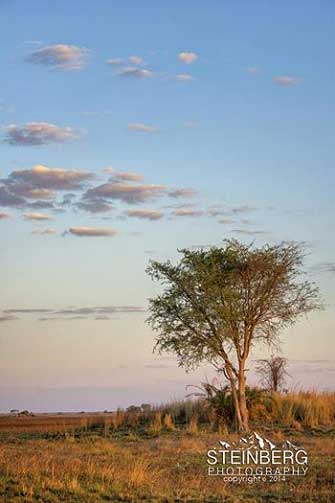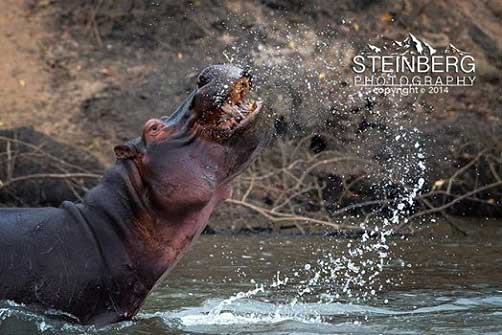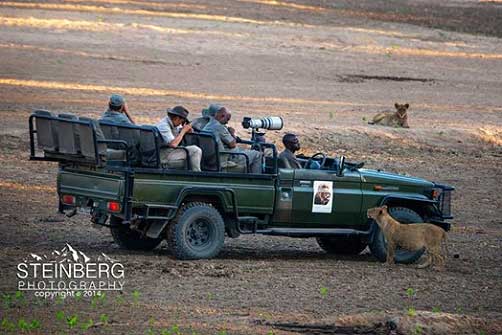A Pied Kingfisher (Cerylerudis) patrols over a hippopotamus (Hippopotamus amphibius) in a drying channel of the Lafupa River in the Kafue National Park, Zambia. As the hippo moves through the water, it makes a bit of a commotion, stirring up bugs and small fish to the surface. The kingfisher knows that with the help of the hippo, those bugs and small fish are easy prey. When the time is right, he will swoop down and take his food directly from the roiled up water.
All posts by admin
Sparse Mopane Tree sits atop a small dambo
At dusk, a lone, sparse Mopane tree (Colophospermummopane) sits atop a small dambo on the Busanga Plains in the Kafue National Park. During the rainy season, with just this little bit of eleveation, these dambos provide the only dry areas to be found.
All paths lead to the watering hole
All paths lead to the watering hole. As the dry season drags on and the watering holes begin to dry up, the competition for ever-dwindling resources increases. Here we see a shrinking watering hole at the Kafue National Park in Zambia that is now less than half the size that is was just a few months ago.
The Red-billed Quelled
The Red-billed quelled (Queleaquelea) is an interesting little bird. They are very small birds weighing in at less than 20g – (2/3oz!) and are only 12cm tall (41/2 inches). Twice a day they fly in huge flocks looking for food. When they do find their meal, they eat as a group. As a group, and a large one at that, they can take anywhere from minutes to an hour to fly by together. It is quite the spectacle, especially at sunset as pictured here.
Hippos as the Guy Splashing
Hippos (Hippopotamus amphibious) as the guy splashing in the water in this image, are herbivores and generally get out of the water to graze. Often times they have been known to walk as far as 30km in the course of an evening to find food before returning to the water for the day. However, they also seem unopposed to eating whatever might be floating by.
Male and Female Lion in the Middle of Quite the Communication
Here we have a male and female lion (Pantheraleo) in the middle of quite the communication. Lions have one of the most complex behaviors of any felines as they are a very social creature. When resting, lion socialization occurs through a number of behaviors, the most peaceful being head rubbing and social licking. They also communicate through a variety of calls each with a different volume, intensity, tone and tempo. Their communications include snarling, hissing, coughing, meowing, purring and of course, roaring – the loudest roar of any large cat.
Lilac Breasted Roller
: As promised, here is the Lilac Breasted Roller (Coraciascaudatus) as it has just taken to flight showing off its brilliant bright blue wings in full extension. Now that is quite the transformation!
The Lilac Breasted Roller
The Lilac Breasted Roller (Coracias caudatus) is one of my favorite birds with its beautiful bright colors of blue, green, brown and, of course lilac, all over its breast. This critter sits atop trees and bushes checking the ground for insects, scorpions and small lizards upon which it feeds. But, you will be quite surprised when it spreads it’s wings. It looks totally different as its blue wings predominate. Stay tuned for tomorrow’s posting and see for yourself.
Having sundowners along the banks of the Luangwa River
Having sundowners along the banks of the Luangwa River in Zambia is something always to be enjoyed. When we have an afterglow like this to light up the river and reveal the numerous pods of hippos still swimming before dinner, it is even better. Such a great way to end the day and the week. Happy Friday, everyone!
One of the bigger aspects of safari is “the hunt”
One of the bigger aspects of safari is “the hunt”. Today we do this with cameras as our weapons, as the hunting of bush animals in Zambia is not permitted. In fact, the penalty for poaching is 3 years hard labor. However, sometimes, more realistically much of the time, one never really knows who is hunting whom. Here we see one of the vehicles from Lion Camp in the South Luangwa National Park that had been tracking a pride of Lions called, The Hollywood Pride. When lo and behold there they were. One of the females found them while another looks on with interest in the background. It seems ironic that the poor chap from Sri Lanka in the right front seat had his 600mm bazooka and was unable to get anything of the interaction, while Jen from Australia in the back got some wonderful images with her little Canon and small zoom. You’ll notice that no one put a hand out to try and pet the lioness!
South Luangwa National Park in the Eastern Province of Zambia
It has not rained for almost 5 months now in the South Luangwa National Park in the Eastern Province of Zambia, as well as the rest of the country. The result is that the rivers are low and as the heat increases they get lower every day, thus concentrating the animals and increasing the competition for the ever diminishing food supply. It also means that the air is full of dust, smoke and other particulates that render the sun an intense, fierce orange and red every morning and evening as it is near the horizon. It also means that we lose the sun well before it goes below the horizon because of the “thickness” of the air.
An Evening Game Drive in the South Luangwa National Park
While on an evening game drive in the South Luangwa National Park in eastern Zambia, we ran across the largest herd of elephants I have ever encountered. We counted more than 60 in this one spot eating, dusting themselves off, and generally being pretty social, at least with each other. This one particular baby wanted to get a closer look at us, but not without her mother. The closer she got, the more she retreated under Mom. Thank goodness Mom seemed pretty relaxed with us as evident in her body language. It was but one of the several interesting behaviors we got to observe that evening.
TThe Luangwa River in Zambia’s Eastern Province
The Luangwa River in Zambia’s Eastern Province looks small and quiet here. Don’t be fooled, though. During the rainy season, Zambia’s 4th largest river will fill and overflow these banks to the far side, at some points in this area exceeding 3km across! Now, that’s a lot of water. The Muchinga Escarpment is seen in the background forming the western boundary for the South Luangwa National Park.
Beautiful wildflowers soaking up the sun’s rays
Beautiful wildflowers soaking up the sun’s rays high up in the Porphyry Gulch of the San Juan Mountains of Southwest Colorado, The vibrant red and yellow Indian paintbrush or prairie-fire (Castilleja) pair magnificently with the red hue of the rocky mountainside.
Yampa Valley Mountain Range
Gazing into the Yampa Valley and out into the distant mountain range, we watched as the sunrise began to inch it’s way above the mountain tops. Even before the sun breaks over the mountains, the light of early morning illuminates the remnants of the evening’s clouds with a beautiful soft, pink glow.














